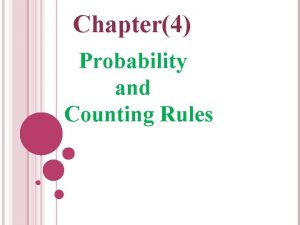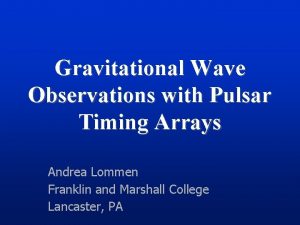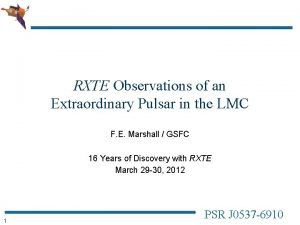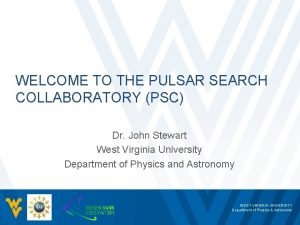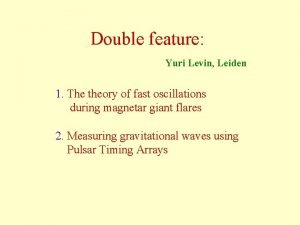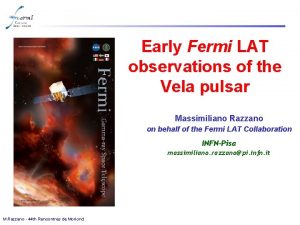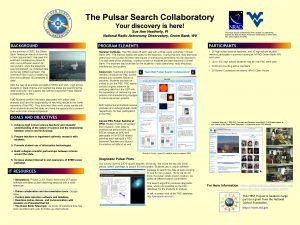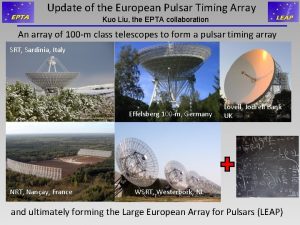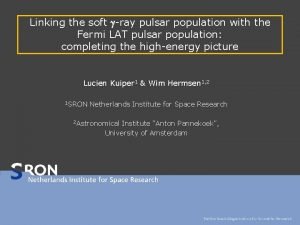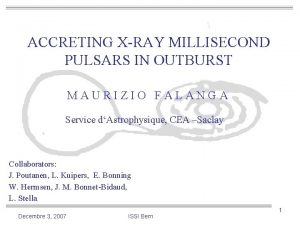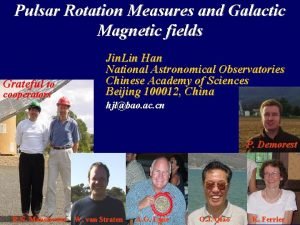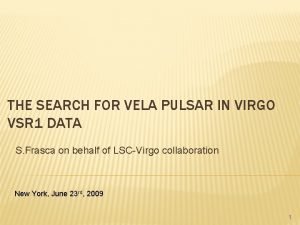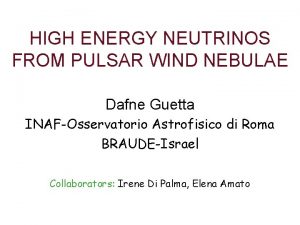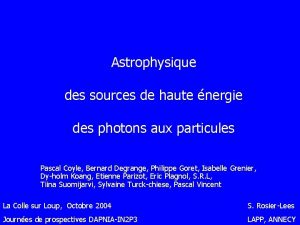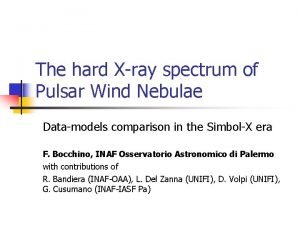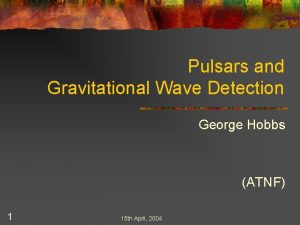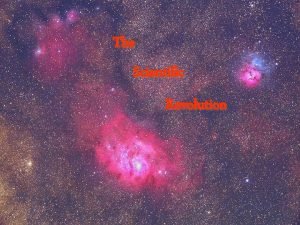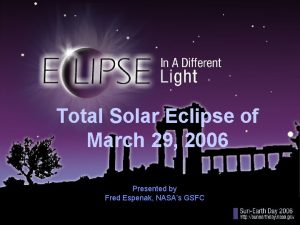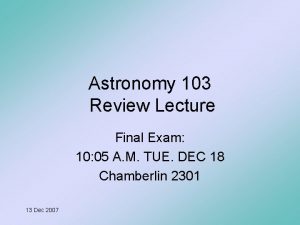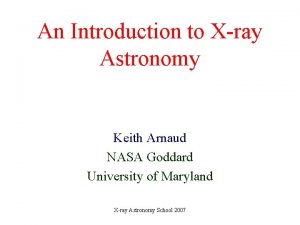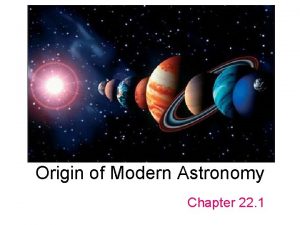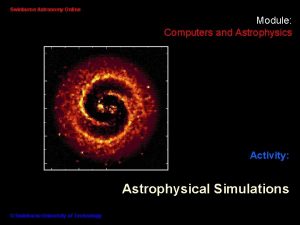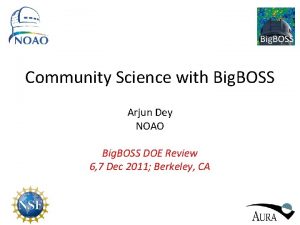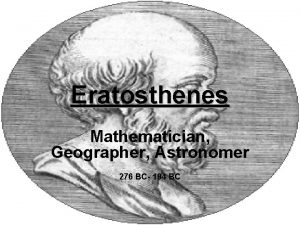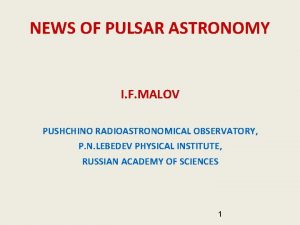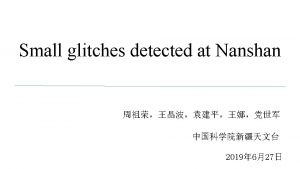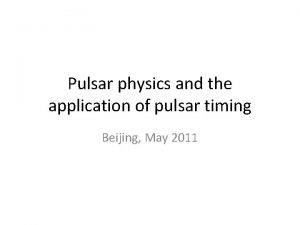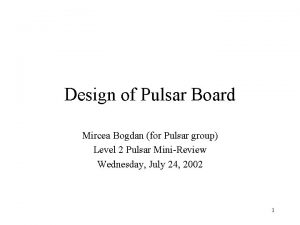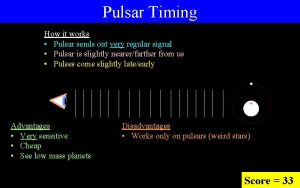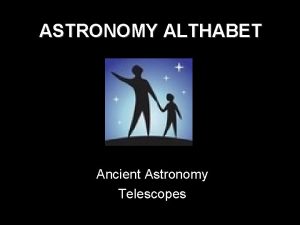NEWS OF PULSAR ASTRONOMY I F MALOV PUSHCHINO







































- Slides: 39

NEWS OF PULSAR ASTRONOMY I. F. MALOV PUSHCHINO RADIOASTRONOMICAL OBSERVATORY, P. N. LEBEDEV PHYSICAL INSTITUTE, RUSSIAN ACADEMY OF SCIENCES 1

PULSARS Pulsars are sources showing pulsed radiation with regular interval between successive pulses. 1)radio pulsars, 2)X-ray pulsars, 3)anomalous X-ray pulsars (AXPs), 4)soft gamma-ray repeaters (SGRs), 5)compact central objects (CCOs) in supernova remnants, 6)X-ray dim isolated neutron stars (XDINSs), 7) rotational radio transients (RRATs). 2

RADIO PULSARS Fig 1. Distribution of pulsar periods from R. N. Manchester, G. B. Hobbs, A. Teoh, & M. Hobbs, , AJ, 129, 1993 -2006 (2005). 3

RADIO PULSARS Fig. 2. Distribution of derivatives of pulsar periods. 4

RADIO PULSARS These two distributions display the obvious bimodality, indicating that pulsars with periods less than tens of milliseconds will never become “normal, ” since this would require a time exceeding the age of the Universe. For example, for a pulsar with P = 10 ms and d. P/dt = 10 -19 the time required to acquire a period of 1 s is 300 billions years. 5

RADIO PULSARS Using the method of principal components we have shown that two clusters of pulsars can be distinguished in phase spaces constructed for various parameters of pulsars. For example, Fig. 3 shows projections in space of three eigenvectors calculated by using four parameters (P, L, W 10 and Z) [A. A. Loginov, I. F. Malov, ARep, 57, 1001 (2013)] : F 1 = 3: 7108 P − 1: 2804 log L + 3: 3482 W 10 + Z F 2 = − 0: 3693 P + 1: 8980 log L + 0: 8377 W 10 + Z (1) F 3 = − 0: 1283 P − 0: 4167 log L − 0: 3154 W 10+ Z In (1) P is a pulsar period, L its luminosity, W 10 width of its pulse at the 10% level and Z its distance from the Galactic plane. 6

RADIO PULSARS Fig 3. Projections of the pulsar distribution at the planes (F 2, F 3), (F 1, F 3) и (F 2, F 3). 7

RADIO PULSAES Using other parameters (flux density S 1400 , rates of the rotation energy losses d. E/dt, magnetic fields at the surface Bs and at the light cylinder Blc and some others) we obtain the same result - two clusters of pulsars can be distinguished in any phase spaces. The main classifying parameter for these clusters is the pulsar period. One of them is characterized by the short periods (P < 0: 1 sec), another by P > 0: 1 sec. The separate analysis shows that distributions of pulsars for Z > 0 and Z < 0 are identical. 8

RADIO PULSAES Hence we can conclude that there are two populations of radio pulsars which must differ by their characteristics and probably by radiation mechanisms. Indeed as we have shown [A. A. Loginov, I. F. Malov, ARep, 58, 733 (2014). A. A. Loginov, I. F. Malov, ARep, 59, 1053 (2015)] they have some differences in the dependences of luminosities on magnetic inductions at the surface and near the light cylinder, efficiencies of transformation of rotation energy in radiation, polarization characteristics, frequencies of nullings and some others. 9

RADIO PULSARS The main reason of such differences is the different sizes of their magnetospheres. It is supposed usually that the border of the magnetosphere is the surface of the light cylinder, where the linear rotation velocity is equal to the speed of light c. Radius of this cylinder is c. P rlc =‒‒‒‒‒‒‒ 2π For pulsars with long periods it much more than the radius of the neutron star R~ 10 km (up to 104 R). However in pulsars with millisecond periods rlc is equaled to values from 7 R to several dozens of R. In the first case the curvature mechanism of radiation is realized. In the second one emitting electrons acquire sufficient pitch – angles [6] to switch on the synchrotron mechanism. 10

RADIO PULSARS There are correlations between pulsar luminosities and magnetic fields at the light cylinder for pulsars with P < 0. 1 sec. Fig. 4. Relationship between radio luminosity and magnetic induction at the light cylinder for 31 pulsars 2 with P < 0. 1 sec. Lradio is measured in m. Jy kpc at 1400 MHz] 11

RADIO PULSARS Some of radio pulsars emit X-ray and/or gammaray radiation. For such sources correlations between luminosities in these ranges and magnetic inductions at the light cylinder are seen also. For gamma-pulsars detected by LAT Fermi magnetic fields near the light cylinder( 103 - 104 G) are three-four orders higher than for the bulk of “normal” pulsars. This lead to the conclusion that hard radiation is generated in the outer layers of pulsar magnetospheres [ I. F. Malov, M. A. Timirkeeva. ARep, 59, 865 (2015)]. 12

RADIO PULSARS Fig. 5. Dependence of gamma-luminosity on magnetic induction near the light cylinder. 13

RADIO PULSARS Sometimes we can see curvature and synchrotron radiation. In this case intensities at high frequencies can grow and become higher than curvature ones. Fig. 6 Scheme of the spectrum of pulsars with curvature and synchrotron emission 14

RADIO PULSARS Such pulsars are detected indeed. D. Morris et al. Astron. Astrophys. , 322, L 17 (1997). Fig. 7. Pulsars with the flattening or increasing of flux densities at high frequencies. 15

RADIO PULSARS We can expect that the curvature radiation can pass by observer, , and he will see the synchrotron emission only. In this case we will detect a pulsar emitting at very high frequencies only. Fig. 8 Microwave pulsar 16

RRATs This class is divided by two subclasses. One of them is so called fast radio bursts (FRBs), characterized by rare individual pulses. The signal in Fig. 9 shows the clear dispersion with DM = 375 pc cm-3 and the source can be located at the distances up to 1 Gpc. This moment about 20 such sources are known. . However there is no generally accepted explanation. The emission region is estimated to be no larger than a few hundred kilometers. If the bursts come from cosmological distances, their sources must be very bright. One possible explanation would be a collapse of black holes or neutron stars. FRBs could be related to hyperflares of magnetars. Fig. 9. Fast radio burst FRB 010724 [D. R. Lorimer et al. Science, 318, 777 (2007)]. 17

RRATs The second type contains “sometimes pulsars”. They show quasi-regular switching on’s and switching off’s of pulsed emission. The behaviour of this type of RRATs is illustrated by Fig. 10 where we show a) a typical sequence of observations covering a 20 -month interval ( black lines), b) the appearance of the quasiperiodic nature, c) histograms of the durations of the on (solid) and off (hatched) phases for PSR B 1931+24 Fig. 10. Time variation of the radio emission of PSR B 1931+24 [M. Kramer et al. Science 312, 549 (2006)]. 18

RRATs One possible origin of the switching on and off of the radiation in PSR B 1931+24 is precession of a relic disk around the pulsar with a precessional period of about 30– 40 days. If such a disk is in the equatorial region, it can occasionally “lock up” the pulsar radiation. Searches for traces of such a disk, e. g. , of its infrared radiation, are necessary. The possible existence of relic disks around pulsars with transient radiation was also considered in. [Z. Wang et al. Nature 440, 772 (2006). X. -D. Li, Astrophys. J. 646, L 139 (2006)]. . The presence of precession is not a mandatory element in the proposed model. Locking and unlocking of the radiation cone could be due to inhomogeneity of the surrounding disk. In this case, due to differential disk rotation, dense inhomogeneities sometimes fall in the line of sight, hindering the propagation of the pulsar radiation. Fig. 11. Geometry of radiation in the pulsar PSR B 1931+24 19

COMPACT CENTRAL OBJECTS (CCOs) 1) They are inside SNRs near their centers. 2) no pulsar wind nebulae (PWNs). 3) no optical/infrared companions, 4) quiet non-pulsed X-ray radiation ( Lx ~ 1033 erg/s) with thermal spectra (0. 2 -0. 4 ke. V). 20

CCOs For typical CCO J 1852+0040 Р = 0. 105 sec, d. P/dt < 2 10 -16 s/s ↓ Bs = 6. 4 1019 (P d. P/dt)1/2 < 3 1011 G d. E/dt = I Ω dΩ/dt <7 1033 erg/s Lx = 3 1033 erg/s ↓ Rotation energy + accretion. The observed X-rays are thermal due to cooling of the surface ( may be accretion gives an input). 21

CCOs ССО 1 E 1207. 4+5209 (1 Е 1207) in the SNR G 296. 5+10. 0. P=424 msec, d. P/dt ≤ 10^(-16) Bs ≤ 3. 5 1011 G Lines at 0. 7, 1. 4 ke. V and possibly at 2. 1 и 2. 8 ke. V → Bs = 6 1010 G. d. E / dt < 1. 5 1032 erg/s → X-rays are caused by cooling of the surface and accretion. A weak magnetic field explain the lack of PWNs around CCOs. Moreover it gives the possibility for penetrating of ambient matter inside the light cylinder and realize the propeller regime. 22

XDINSs An SNR disappears after the definite time and we observe XDINS emitting due to the rotation, cooling of the surface and accretion from a debris disk. Lines in the X- ray spectra give the values of magnetic fields near the values characterizing CCOs. 23

X-RAY PULSARS Emission of these objects is caused by the accretion of the stellar wind matter from the secondary companion onto the neutron star. More than 400 binary systems with accretion have been discovered to this moment. There is no radio emission from them. They emit X-ray radiation only. The characteristics of these systems and the main features of their radiation can be found in the review [I. Caballero and J. Wilms. Mem. S. A. It. Vol. 75, 282. Astroph/1206. 3124 v 1]. Fig. 12. Scheme of an X-ray pulsar 24

AXPs + SGRs Anomalous X-ray pulsars and soft gamma-ray repeaters were discovered some years ago, but their nature remains unclear. The presence of a periodic pulsed component in their radiation with a period of a few seconds suggests that the central object is most probably a single neutron star, since no signs of a companion were found. The main difference of AXPs from other X-ray pulsars is the persistent increasing of intervals between successive pulses by values 10 -13 - 10 -11 s/s. Periods of X-ray pulsars show a secular decreasing. In addition, AXPs are characterized by the following features: (1) a fairly narrow range of periods (6– 12 s); (2) association with supernova remnants for some objects. 25

AXPs + SGRs The second group (SGRs) includes currently only a few objects. Their intervals between pulses are in the same interval (2– 8 s). In contrast to the AXPs, only SGR 1900+14 has a persistent component of its X-ray emission. In the other objects, X-ray emission is observed either only in the quiescent state (SGR 1627− 41 and SGR 1806− 20) or, on the contrary, in periods of active gammaray emission (SGR 0525− 66). The rate of deceleration of SGRs is usually greater than for AXPs, and their ages seem lower. For example, the ages of two SGRs (SGR 1806− 20 and SGR 1900+14) were estimated to be 1400 and 780 yr. All SGRs seem to be associated with supernova remnants, but, in constrast to AXPs, they are shifted from the centers, and the average velocities of SGRs are greater than those of AXPs (from 100 km/s for SGR 1806− 20 to > 1000 km/s for SGR 1900+14). The most important peculiarity of SGRs is the presence of sporadic bursts of gamma radiation with flare energies of order of 1044 erg and more. 26

AXPs + SGRs Fig. 13. Periodic X-ray radiation of some AXPs and SGRs. 27

AXPs + SGRs SGR 1900+14 28

AXPs + SGRs Models: ) Magnetars 1 Bs = 6. 4 1019 (P d. P/dt)1/2 ~ 1014 – 1015 G 2) Accretion 3) Precession 4) White dwarfs with high magnetic fields (Bs ~ 108 – 109 G) 5) Strange stars 6) Drift waves 29

AXPs + SGRs Now the magnetar model is the most popular. It is suggested in this model that there are very strong magnetic fields inside the neutron star (~ 1016 G). They give the main source of energy for all processes in the pulsar magnetosphere and for the observed radiation. [R. C. Duncan, C. Thompson. Astrophys. J. , 392, L 19 (1992)]. A lot of theoretical works try to describe all peculiarities of AXPs and SGRs. We have no time to discuss their successes and dificulties. In fact there are difficulties in all known models. This moment two alternative models are worked out, namely the accretion model and the drift one. 30

AXPs + SGRs Drift model [I. F. Malov, G. Z. Machabeli. Astron. Astrophys. Thans. , 25, 7 (2006)] Fig. 14. The transverse waves near the light cylinder 31

AXPs + SGRs Dependence of α on time. α is the angle between the line of sight and the axis of the emission cone. 32

AXPs + SGRs 1) Values 4 π2 I d. P/dt d. E/dt=—————— P 3 are higher than 1037 erg/sec for many objects under consideration. They are quite enough to provide observed X-ray luminosities of AXPs and SGRs and an input of relativistic particles in SNRs surrounding them. 2) The calculated rotation periods for objects of our sample are rather short. The mean value is <P> = 108 msec. It is worth noting that the mean period of AXPs (<P> = 64. 60 msec) is shorter than the SGR period (<P> = 194. 75 msec). 3) Magnetic fields are of the same order (<log Bs> = 12. 08), as for the normal pulsars. It is worth noting that Bs for SGRs in average 2. 5 times higher (<log Bs> = 12. 35), than for АХРs (<log Bs> = 11. 94). Probably this circumstance explains more higher power of observed processes in SGRs. 33

AXPs + SGRs To explain the very energetic gamma-ray flairs we must suggest some nuclear reactions near the surface due to an ejection of heavy nuclei from the neutron star [ G. S. Bisnovatyi-Kogan, N. R. Ikhsanov. ARep. , 58, 217 (2014)]. 34

CONCLUSIONS 1. More than 2500 known radio pulsars can be separated in two populations : 1) with periods P > 0. 1 sec and 2) with P<0. 1 sec. They differ by some parameters and by radiation mechanisms. 2. There are two types of RRATs. The first type is characterized by quasi-regular switching on and switching off periods, the second one by sporadic pulses showing the dispersion on frequency. The nature of both types is unclear up to now. 35

CONCLUSIONS 3. Compact central objects in SNRs are neutron stars with low magnetic fields at the surface. 4. After scattering of SNR”s matter XDINS remains. It radiate thermal emission from the surface. 5. X-ray pulsars are invisible in radio range. They are members of binary systems and radiate due to an accretion of matter of stellar winds from the secondary companions. 36

CONCLUSIONS 6. Anomalous X-ray pulsars and Soft gamma-ray repeaters are magnetars with Bs ~ 1014 – 1015 G and Binner ≥ 1016 G as many astrophysicists believe. However the accretion model and the drift one are worked out as well. They describe a number of peculiarities of AXPs and SGRs in the frame of suggestion on the normal magnetic inductions (Bs ~ 1012 G). 37

CONCLUSIONS 7. Pulsars of all classes excluding X-ray pulsars have been registered as radio sources. So we can conclude that their nature is identical. 38

THANK YOU FOR YOUR ATTENTION! 39
 Learning astronomy by doing astronomy
Learning astronomy by doing astronomy Learning astronomy by doing astronomy
Learning astronomy by doing astronomy Learning astronomy by doing astronomy activity 1 answers
Learning astronomy by doing astronomy activity 1 answers Soft news
Soft news Chapter 4 probability and counting rules
Chapter 4 probability and counting rules No news _____ good news.
No news _____ good news. Pulsar
Pulsar Pulsar
Pulsar Pulsar chemie
Pulsar chemie Pulsar search collaboratory
Pulsar search collaboratory Pulsar
Pulsar Yuri levin
Yuri levin Pulsar
Pulsar Pulsar wind
Pulsar wind Pulsar search collaboratory
Pulsar search collaboratory Pulsar timing
Pulsar timing Pulsar
Pulsar Al pulsar el botón derecho del ratón, generalmente
Al pulsar el botón derecho del ratón, generalmente Pulsar
Pulsar Pulsar
Pulsar Vela pulsar
Vela pulsar Pulsar wind
Pulsar wind Pulsar solaire
Pulsar solaire Pulsar wind
Pulsar wind Dtsi engine disadvantages
Dtsi engine disadvantages Pulsar analytics
Pulsar analytics Pulsar
Pulsar Tycho brahe astronomy
Tycho brahe astronomy Astronomy picture of the day
Astronomy picture of the day Chat hull astronomy
Chat hull astronomy Astronomy picture of the day march 29 2006
Astronomy picture of the day march 29 2006 Astronomy
Astronomy Astronomy 103 final exam
Astronomy 103 final exam Astronomy
Astronomy Chapter 22 origin of modern astronomy
Chapter 22 origin of modern astronomy Astronomy in ancient rome
Astronomy in ancient rome Branches of astronomy
Branches of astronomy Swinburne astronomy
Swinburne astronomy Time domain astronomy
Time domain astronomy Eratosthenes contributions
Eratosthenes contributions




